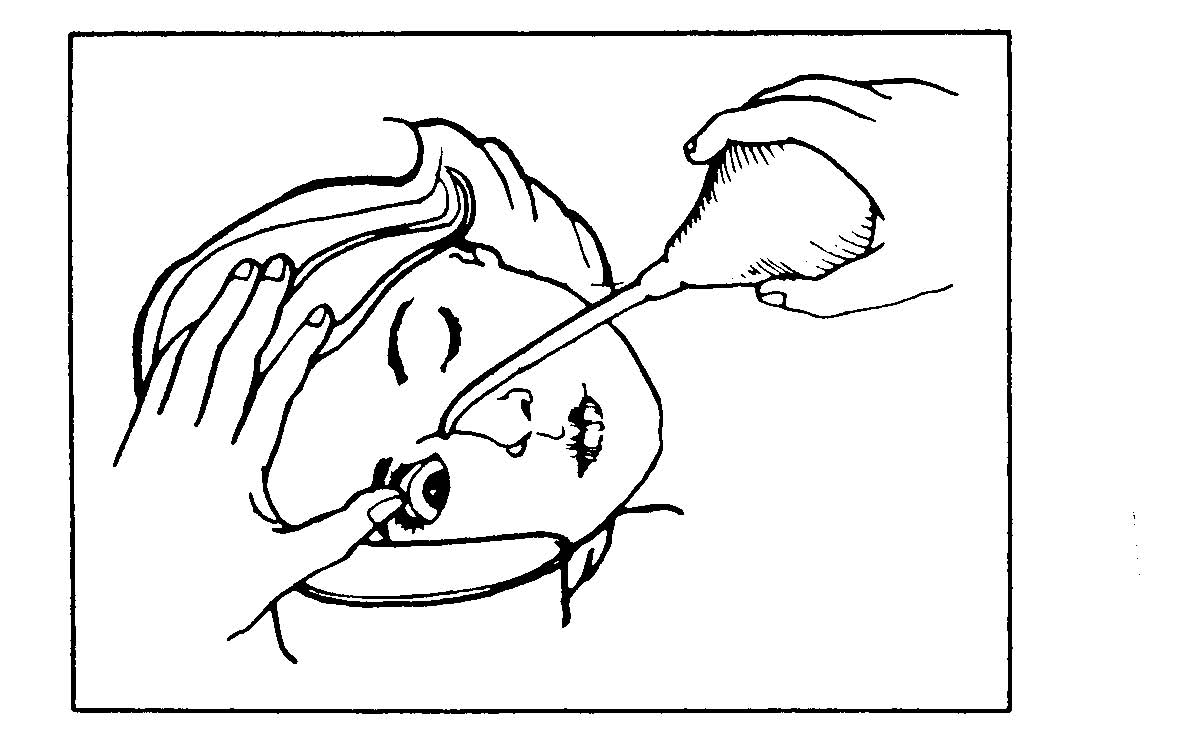Eye, Ear, and Nose Injuries
Lesson 1: Irrigate, Instill Eye Drops, and Apply Ointments to the Eye
1-4
1-4. EYE IRRIGATION
There may be unwanted secretions or foreign bodies (other than impaled objects) in the casualty's eye. (See Lesson 3.) You will irrigate the eye according to the following procedures:
NOTE: Remember to perform a patient care handwash before beginning any
procedure.
a. Gather the following equipment and place them in a sterile area.
(1) Tubing for flushing water/irrigation solution in the eye.
(a) Eye irrigator--asepto bulb syringe.
(b) IV bag with tube.
(c) Plastic bottle.
(d) Equipment to instill medication.
(2) Water/irrigation solution.
(3) Towel.
(4) Gauze/cotton balls.
(5) Catch basin.
(6) Light source.
b. Verify the correctness of the items to include the type of medication, the correct amount/concentration, and the temperature for administration. Ensure the correct eye receives treatment.
c. Ensure the patient is aware of the treatment.
(1) Identify the patient by his name.
(2) Inform the patient about the need for treatment.
(3) Explain the procedure for treatment.
(4) Ask the patient to remove his contact lenses/glasses, if necessary.
d. Position the patient and equipment.
(1) Patient lying in bed.
(a) Place patient in a supine position.
(b) Tilt patient's head slightly to the side to be irrigated.
(c) Cover patient's area that may be splashed by solution with waterproof cover and/or towel, if applicable.
(d) Position the catch basin next to the patient's affected side to catch the flow.
(e) Position the light/lamp. Ensure there is adequate light and avoid shinning the light directly over the patient.
(2) Patient sitting up.
(a) Have the patient place his head in an inclined position to the side to be irrigated.
(b) Tilt the patient's head slightly backwards.
(c) Support the patient's head.
(d) Cover the patient's area that may be splashed by solution with waterproof cover and/or towel, if applicable.
(e) Position the catch basin next to the patient's affected side to catch the flow.
(f) Position the light/lamp. Ensure there is adequate light and avoid shinning the light directly over the patient.
e. Perform a patient care handwash.
f. Prepare the patient for irrigation.
(1) Clean the patient's eyelids with gauze/cotton balls, rinse debris off outer eye.
NOTE: Rinsing helps avoid the spread of contamination.
(2) Separate the patient's lids with your thumb and fingers, hold lids open.
CAUTION: Avoid applying pressure to/on the eyeball.
(3) Tell the patient to look up.
g. Irrigate the patient's eye.
(1) Direct the flow of fluid from the inner to outer canthus along conjunctival sac using only the pressure or force of liquid stream required to maintain a steady flow (see figure 1-2).
Figure 1-2. Flushing the patient's eye.
CAUTION: Use just enough force (flow) to gently dislodge the unwanted
secretions/foreign bodies.
CAUTION: Never touch the patient's eye with the irrigator. It could cause the
spread of infection, contamination, or further injury to the eye.
NOTE: Do not irrigate an impaled object.
(2) Tell the patient to look up to expose the conjunctiva.
(3) Gently flush the patient's eye.
CAUTION: Ensure that the irrigator tip is 1 to 1 1/2 inches away from the patient's
eye.
(4) Dry eyelids by gently patting area surrounding orbit dry as soon as sac is
thoroughly flushed.
CAUTION: Do not pat directly over the patient's eye.
h. Perform a patient care handwash.
i. Record treatment. if necessary.


